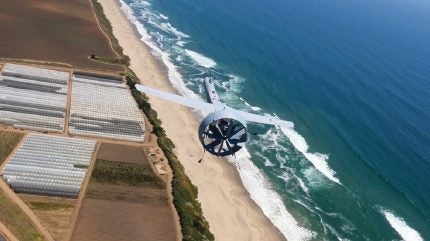
The US Coast Guard has purchased the services of the V-BAT uncrewed aerial system (UAS), a vertical take-off and landing (VTOL) system manufactured by Shield AI, an up-and-coming defence technology startup based in California, in a deal worth $198m on 1 July 2024.
As a branch of the armed forces beholden to the US Department of Defense (DoD), the Coast Guard will augment its intelligence, surveillance and reconnaissance (ISR) operations in the maritime environment through a ‘contractor owned, contractor operated’ model of service.
V-BAT first came to the fore in April 2021 when the DoD provided funds to prototype the system. The UAS features VTOL capabilities and a small footprint, which allow for easy launch, transport and operation. It has a length of 2.74 metres (m) and a wingspan of 2.95m, and weighs 56.6 kilogrammes, including fuel and payload.
The system is also versatile as it is the only single-engine ducted fan VTOL UAS that can switch from take-off mode to vertical hover and horizontal modes during flight. It also offers persistent stare capability throughout a given mission set while maintaining a sensor line of sight.
With more than five years of operational experience at sea, the V-BAT is a flexible platform capable of performing Group 2 to Group 5 UAS missions and beyond, assured the startup.
“We’re excited to support the US Coast Guard with their ISR operations. All maritime vessels will become drone carriers as maritime forces move to deploy distributed, affordable, intelligent drones,” affirmed Shield AI’s President, Co-founder, and former Navy SEAL, Brandon Tseng.
How well do you really know your competitors?
Access the most comprehensive Company Profiles on the market, powered by GlobalData. Save hours of research. Gain competitive edge.

Thank you!
Your download email will arrive shortly
Not ready to buy yet? Download a free sample
We are confident about the unique quality of our Company Profiles. However, we want you to make the most beneficial decision for your business, so we offer a free sample that you can download by submitting the below form
By GlobalData“V-BAT’s selection… is indicative of a broader market movement where increasingly customers are recognising they can accomplish the vast majority of their mission sets with affordable drones rather than exquisite, expensive crewed or uncrewed aircraft.”
A new military UAS market
In Western defence production, there has been a trend in the last few decades since the end of the Cold War to invest in small numbers of highly engineered, complex, and expensive platforms over the mass production of simpler, cheaper, and rugged systems.
“When one is fighting a low-intensity counterinsurgency conflict, such a philosophy lends itself well to providing the ‘absolute best’ for the military to assume minimal risk to one’s own force,” GlobalData Defence Analsyst James Marques commented in a March 2024 briefing.
Lessons from the Russia-Ukraine war demonstrate the growing accessibility to all types of drones. Their attritional approach does not guarantee the most capable platforms, but with larger numbers of crude designs it is inflicting serious attrition on Russian forces. They are hitting both the industrial base and the energy system the Kremlin relies on to fund its invasion.
“When a $500 drone can blow the turret off a $10 million tank, it is time to ask serious questions about economies of scale as the west seeks to scale rearmament,” Marques added.
As a result of this the market is expanding. GlobalData intelligence indicates that the global military unmanned aerial vehicles market is valued at $12.2bn in 2024 and is projected to grow at a compound annual growth rate of 6% over the forecast period. It is expected to reach $21.9bn by 2034 and cumulatively value $190.8bn over the forecast period.



